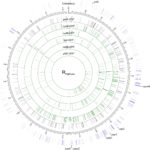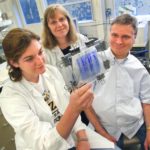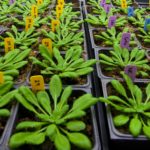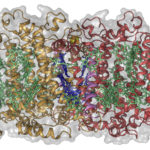Engineering artificial nanofactories modeled on bacterial microcompartments (BMCs) will require a chain of “logistical” vehicles to deliver the products. Making progress on that front, scientists affiliated with Berkeley Lab’s Molecular Biophysics and Integrated Bioimaging Division and the MSU-DOE Plant Research Laboratory have detailed the structure and function of a BMC-associated protein involved in electron transfer, a fundamental part of the assembly line that leads to the production of chemical compounds. The study, published in the journal Biochemistry, was led by Cheryl Kerfeld; Marcus Sutter also collaborated on the project. Read more from the MSU-DOE Plant Research Lab.
Biosciences Affiliate Stephen R. Holbrook Passes Away
 The Berkeley Lab community mourns the loss of Stephen R. Holbrook, who died August 12 at age 68. Holbrook joined the Lab in 1979 as a staff scientist in the Laboratory of Chemical Biodynamics working with Prof. Sung-Hou Kim. He later led his own group in the Physical Biosciences Division, and was an affiliate in the Biosciences Area’s Environmental Genomics & Systems Biology (EGSB) Division. Holbrook’s research interests included the study of nucleic acid crystal structures, protein structures, prediction of novel RNAs, and prediction of protein complexes.
The Berkeley Lab community mourns the loss of Stephen R. Holbrook, who died August 12 at age 68. Holbrook joined the Lab in 1979 as a staff scientist in the Laboratory of Chemical Biodynamics working with Prof. Sung-Hou Kim. He later led his own group in the Physical Biosciences Division, and was an affiliate in the Biosciences Area’s Environmental Genomics & Systems Biology (EGSB) Division. Holbrook’s research interests included the study of nucleic acid crystal structures, protein structures, prediction of novel RNAs, and prediction of protein complexes.
Genome Research Challenges Previous Understanding of the Origin of Photosynthesis
ALS Shines New Light on Evolution of Photosynthesis
Found in muddy soils near hot springs, Heliobacterium modesticaldum is the simplest bacterium known to be able to drive photosynthesis. Its photosynthesis reaction centers are thought to resemble the earliest common ancestor of all photosynthesis complexes, which evolved around three billion years ago. Now, for the first time, a team led by researchers from Arizona State University has obtained a near-atomic resolution (2.2 Å) structure of the membrane protein at the heart of H. modesticaldum’s photosynthetic reaction center using X-ray crystallography data collected at ALS Beamline 8.2.1. The structure gives researchers a new perspective on the early evolution of photosynthesis. Read more in this ALS Science Brief.
JBEI Researchers Improve Membrane Protein Expression And Function Using Genomic Edits
 Development of robust microbial platforms for bioproduction requires strains that have been engineered to have efficient carbon uptake, energy generation, tolerance to biomass pretreatment byproducts and the export of final product. Many of these optimizations require expression and overexpression of native and heterologous membrane proteins. Over the years, scientists at the U.S. Department of Energy’s Joint BioEnergy Institute (JBEI), and others have successfully found many such engineering targets. However, JBEI has also found that expression of membrane proteins is challenging and can also impact the microbial growth, thus negatively limiting the use of these discoveries. Read more from JBEI.
Development of robust microbial platforms for bioproduction requires strains that have been engineered to have efficient carbon uptake, energy generation, tolerance to biomass pretreatment byproducts and the export of final product. Many of these optimizations require expression and overexpression of native and heterologous membrane proteins. Over the years, scientists at the U.S. Department of Energy’s Joint BioEnergy Institute (JBEI), and others have successfully found many such engineering targets. However, JBEI has also found that expression of membrane proteins is challenging and can also impact the microbial growth, thus negatively limiting the use of these discoveries. Read more from JBEI.
- « Previous Page
- 1
- …
- 137
- 138
- 139
- 140
- 141
- …
- 213
- Next Page »
Was this page useful?








